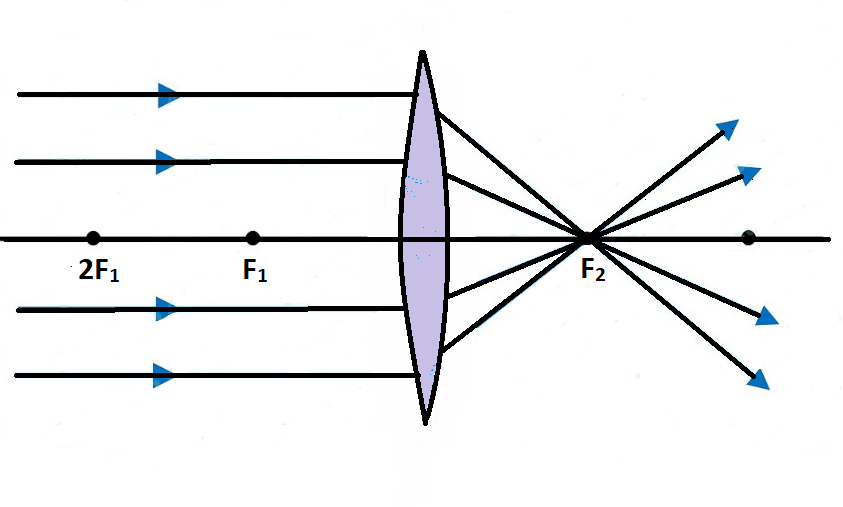
Draw ray diagram showing the image formation by a convex lens when an object is placed at infinity.
Answer
517k+ views
- Hint: The property of a convex lens is that it converges the light rays passing through them. The nature of image formed by the lens depends on the distance of the object from the lens. Depending on that, the image can be real or virtual, erect or inverted, diminished or magnified.
Complete step-by-step solution -

When an object is placed at infinity then its real image will be formed at the focus (${F_2}$).
The image formed in this situation when object is placed at infinity, has the following characteristics:
(1). Real image
(2). Inverted image
(3). Highly diminished image
Additional Information:
A lens is basically a carefully grounded piece of transparent material which refracts light rays in such a way as to form an image.
There are two types of lenses: Convex Lens (Converging) and Concave Lens (Diverging).
A converging lens causes light rays that are parallel to the principal axis to converge or meet, at one point (the principal focus).
A diverging lens causes parallel light rays to diverge or spread apart.
Real image and virtual image:
A real image is formed when light rays pass and diverge from the image point actually. Real images can be displayed on screens.
A virtual image is formed when light rays do not pass through the image point but only appear to diverge from the image point. Virtual images cannot be displayed on screens.
Convex lens always forms a real image except the situation when the object is placed between the optical centre (O) and focus (${F_1}$).
Note: 1. All distances to the left of the lens are taken to be negative while all distances to the right of the lens are taken to be positive.
2. A real image can be obtained on a screen while a virtual image cannot be obtained on a screen.
Complete step-by-step solution -

When an object is placed at infinity then its real image will be formed at the focus (${F_2}$).
The image formed in this situation when object is placed at infinity, has the following characteristics:
(1). Real image
(2). Inverted image
(3). Highly diminished image
Additional Information:
A lens is basically a carefully grounded piece of transparent material which refracts light rays in such a way as to form an image.
There are two types of lenses: Convex Lens (Converging) and Concave Lens (Diverging).
A converging lens causes light rays that are parallel to the principal axis to converge or meet, at one point (the principal focus).
A diverging lens causes parallel light rays to diverge or spread apart.
Real image and virtual image:
A real image is formed when light rays pass and diverge from the image point actually. Real images can be displayed on screens.
A virtual image is formed when light rays do not pass through the image point but only appear to diverge from the image point. Virtual images cannot be displayed on screens.
Convex lens always forms a real image except the situation when the object is placed between the optical centre (O) and focus (${F_1}$).
Note: 1. All distances to the left of the lens are taken to be negative while all distances to the right of the lens are taken to be positive.
2. A real image can be obtained on a screen while a virtual image cannot be obtained on a screen.
Recently Updated Pages
A man running at a speed 5 ms is viewed in the side class 12 physics CBSE

The number of solutions in x in 02pi for which sqrt class 12 maths CBSE

State and explain Hardy Weinbergs Principle class 12 biology CBSE

Write any two methods of preparation of phenol Give class 12 chemistry CBSE

Which of the following statements is wrong a Amnion class 12 biology CBSE

Differentiate between action potential and resting class 12 biology CBSE

Trending doubts
What are the major means of transport Explain each class 12 social science CBSE

Which are the Top 10 Largest Countries of the World?

Draw a labelled sketch of the human eye class 12 physics CBSE

Explain sex determination in humans with line diag class 12 biology CBSE

Explain sex determination in humans with the help of class 12 biology CBSE

Differentiate between homogeneous and heterogeneous class 12 chemistry CBSE




